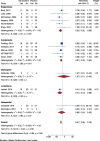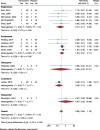Acceptability, equity, and feasibility of using antipsychotics in children and adolescents with autism spectrum disorder: a systematic review
- PMID: 33238921
- PMCID: PMC7687819
- DOI: 10.1186/s12888-020-02956-8
Acceptability, equity, and feasibility of using antipsychotics in children and adolescents with autism spectrum disorder: a systematic review
Abstract
Background: It is unclear whether the administration of antipsychotics to children and adolescents with autism spectrum disorders (ASD) is acceptable, equitable, and feasible.
Methods: We performed a systematic review to support a multidisciplinary panel in formulating a recommendation on antipsychotics, for the development of the Italian national guidelines for the management of ASD. A comprehensive search strategy was performed to find data related to intervention acceptability, health equity, and implementation feasibility. We used quantitative data from randomized controlled trials to perform a meta-analysis assessing the acceptability and tolerability of antipsychotics, and we estimated the certainty of the effect according to the GRADE approach. We extracted data from systematic reviews, primary studies, and grey literature, and we assessed the risk of bias and methodological quality of the published studies.
Results: Antipsychotics were acceptable (dropouts due to any cause: RR 0.61, 95% CI 0.48-0.78, moderate certainty of evidence) and well tolerated (dropouts due to adverse events: RR 0.99, 95% CI 0.55-1.79, low certainty of evidence) by children and adolescents with ASD. Parents and clinicians did not raise significant issues concerning acceptability. We did not find studies reporting evidence of reduced equity for antipsychotics in disadvantaged subgroups of children and adolescents with ASD. Workloads, cost barriers, and inadequate monitoring of metabolic adverse events were indirect evidence of concerns for feasibility.
Conclusion: Antipsychotics in children and adolescents with ASD were likely acceptable and possibly feasible. We did not find evidence of concern for equity.
Keywords: Antipsychotic agents; Autism Spectrum disorder; GRADE approach; Guideline; Systematic review.
Conflict of interest statement
The authors declare that they have no competing interests.
Figures
References
-
- American Psychiatric Association . Diagnostic and statistical manual of mental disorders. 5. Arlington: Author; 2013.
-
- Christensen DL, Braun KVN, Baio J, Bilder D, Charles J, Constantino JN, et al. Prevalence and Characteristics of Autism Spectrum Disorder Among Children Aged 8 Years - Autism and Developmental Disabilities Monitoring Network, 11 Sites, United States, 2012. MMWR Surveill Summ. 2018;65(13):1–23. doi: 10.15585/mmwr.ss6513a1. - DOI - PMC - PubMed
Publication types
MeSH terms
Substances
LinkOut - more resources
Full Text Sources
Medical



